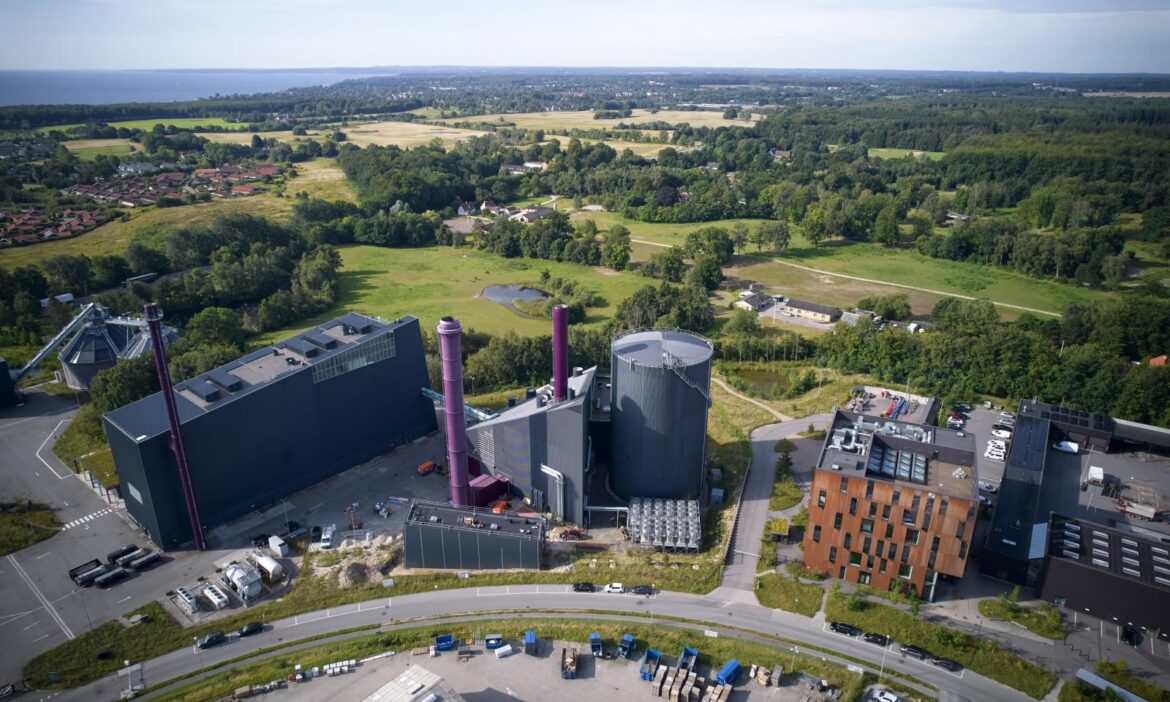A full 23 percent of this year’s heat production for Forsyning Helsingør’s district heating customers comes from the new electric boiler at Helsingør Combined Heat and Power Plant – far exceeding expectations.
November 14, 2025 | By Kim Vejrup, Danish District Heating Association
The electric boiler – seen here in the foreground – was commissioned in May this year and has already accounted for 23 percent of total heat production, far above what was anticipated. Photo: Forsyning Helsingør
When the new electric boiler at Helsingør Combined Heat and Power Plant was officially inaugurated in May, expectations were high. A recent performance review now shows that production has taken off so successfully that those expectations have already been surpassed – within the very first year of operation.
The initial estimate was that the boiler would supply around 10 percent of the total district heating demand. However, figures through September reveal that the new electric boiler has produced 23 percent of Helsingør’s total heat output, including all boilers and production units.
“It’s remarkable that the electric boiler already delivers such a large share of our heat production in its first year. This bodes well for the future – and it’s good news for the climate,” says Chairman Jens Bertram, adding:
“Electric-based district heating technologies like this one are helping to phase out fossil fuels and integrate more solar and wind power into the electricity system. As the boiler also brings both income and savings to the plant, this strong start supports continued competitive district heating prices for customers in North Zealand.”
At Helsingør CHP plant, the increased use of the electric boiler has also helped reduce biomass consumption. From January through September 2025, wood chip use fell by 13 percent compared to budgeted levels. However, biomass use also depends on other factors such as weather conditions and fuel prices.
Multiple technologies strengthen supply security
The installation of the electric boiler is only one of several initiatives at Helsingør CHP plant, which aims to integrate additional electric-based district heating technologies in the coming years.
“As district heating expands to more customers across North Zealand, we must continuously expand and future-proof production – ideally through proven, electricity-based district heating technologies,” explains Energy Manager Hans Peter Balle.
He notes that the new electric boiler is the first step, while larger heat pumps at the plant and closer to end-users are part of the long-term strategy.
The energy manager also emphasizes that the new boiler improves security of supply:
“Flexibility is key when producing energy in Denmark. Wind, solar radiation, temperature, prices, grid pressure, and external events all fluctuate and influence both the need and the opportunity to produce energy. The more diverse our energy portfolio, the better we can deliver – to both customers and society,” says Hans Peter Balle.
The electric boiler strengthens the plant’s production mix and resilience. It can also be activated when electricity production in the national grid exceeds demand.
“In that case, we can step in, use the surplus electricity, and instead produce heat for customers in North Zealand. That’s smart energy use,” concludes Hans Peter Balle.
Facts about the Electric Boiler
- Production capacity: 30 MW district heating
- Can cover up to 20% of the heat demand – equivalent to approx. 4,000 households
- Can replace up to 20% of biomass consumption
- Can reduce the use of natural gas during peak load
- Can help balance the electricity grid – allowing output to be increased or decreased depending on power surplus or deficit in the system
Translation from the original article in Danish by Kim Vejrup, Danish District Heating Association – Photo: Helsingør Forsyning
 Curious to learn more?
Curious to learn more?
You can find all our district energy news here.
